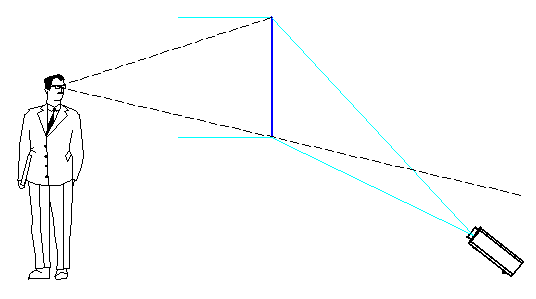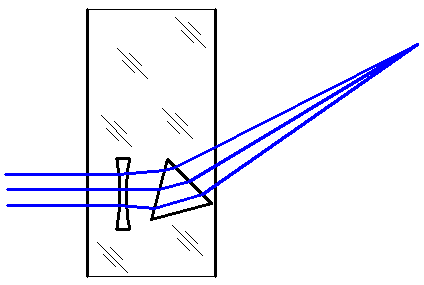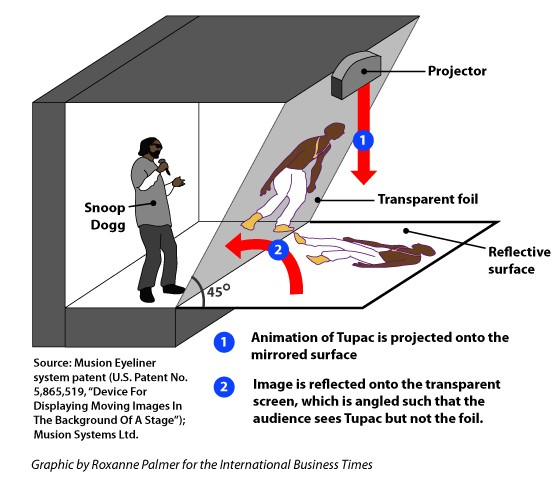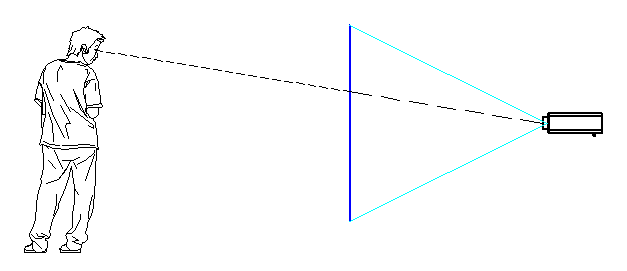Pseudo-Holography Screen Technologies
In this article, I will show you several ways to create pseudo-holographic images. “Pseudo” because the image is actually flat, but the well-designed lighting and background create the illusion of volume.
The principle of operation is shown in the following figure (in the diagram, the projector is located below, and in the video above):

As can be seen from the diagram, the observer does not see the projector’s lens, so it’s rather difficult to understand how the image is formed.
The principle of the film: The

film consists of an array of microprisms and microlenses. Prism redirects a beam of light, its lens will defocus in such a way that at the output a parallel beam of rays is obtained.
As you understand, where the lens / prism is, there are aberrations: this film (of any manufacturer) has rather poor color rendering and small viewing angles at which critical color distortion does not occur. For example, if you crouch in front of this screen, the upper part will go into the blue range, and the lower part will go into red.
http://www.youtube.com/watch?v=zSxBW-rKmeY
From 2:24, Snoop Dog (real) appears.
This bearded technology was used as early as the 16th century ( proof on wiki ), though with static images. Roxana Palmer made an excellent illustration of this method:

As the film is used Musion Eyeliner , other manufacturers, frankly, I do not even know.
The principle of operation is similar to Pepper's ghost:

Production of such products was also established in Russia because a conventional tint film with a certain reflection index is used as a special film.
All sorts of variations on this subject are also presented on the market:
http://www.youtube.com/watch?v=DTXO7KGHtjI
The principle of work to the disgrace is simple.

The screen consists of a grid with a fine cell, consisting of thin-thin lines. Thus, a person sees through the film, as well as the image on the film formed by the projector and scattered by the screen threads.
It is clear that such a screen should be observed from a decent distance, so as not to distinguish between cells and threads of the screen.
The only drawback of this method is that the viewer sees through the screen a projector lens that can blind. However, in concert halls the projector is perceived as one of the lighting fixtures.
Using ultrasonic generators, fog is created from the water, which is guided by an array of fans. A wall of fog scatters the radiation from the projector.
Live, of course, does not look as impressive as Pepper's ghost, but it has its own niche, as evidenced by a couple of manufacturers of these screens.
The mirror rotates at a speed of 20 revolutions per second and reflects the image formed by the projector. For each rotation of the mirror by 1.25 degrees, the projector forms a new image, so a unique picture will be observed from any angle, creating the illusion of the volume of the object.
This is probably the real holographic image. A focused laser beam ionizes the gas, which in turn generates light at a given point.
Of course, far from commercial products, but the technology is already impressive!
Translucent film pseudo-hologram
The principle of operation is shown in the following figure (in the diagram, the projector is located below, and in the video above):

- The projector shines on the film at a certain angle;
- The film redirects the flow of the projector to the viewer;
As can be seen from the diagram, the observer does not see the projector’s lens, so it’s rather difficult to understand how the image is formed.
The principle of the film: The

film consists of an array of microprisms and microlenses. Prism redirects a beam of light, its lens will defocus in such a way that at the output a parallel beam of rays is obtained.
As you understand, where the lens / prism is, there are aberrations: this film (of any manufacturer) has rather poor color rendering and small viewing angles at which critical color distortion does not occur. For example, if you crouch in front of this screen, the upper part will go into the blue range, and the lower part will go into red.
Pepper's ghost
http://www.youtube.com/watch?v=zSxBW-rKmeY
From 2:24, Snoop Dog (real) appears.
This bearded technology was used as early as the 16th century ( proof on wiki ), though with static images. Roxana Palmer made an excellent illustration of this method:

- A reflective screen is placed on the floor;
- A projector (or several projectors) shines on top of the screen;
- A special translucent film is stretched next to the screen;
- All lighting on the stage goes out, only the minimum necessary to give “depth” and accent lighting remains;
- The viewer sees the imaginary Tupac reflected in the film and, at the same time, the real Snoop Dog through the film.
As the film is used Musion Eyeliner , other manufacturers, frankly, I do not even know.
Virtual pyramid
The principle of operation is similar to Pepper's ghost:

- On the horizontal panel, specially prepared content is formed (the panel is located slightly below the eye level of the "average" viewer);
- The pyramid is made of glass / orstekl with a special film like Musion Eyeliner;
- The viewer observes the reflection of the image on the panel in the glass and, at the same time, the highlighted object inside the pyramid.
Production of such products was also established in Russia because a conventional tint film with a certain reflection index is used as a special film.
All sorts of variations on this subject are also presented on the market:
Freeformat
http://www.youtube.com/watch?v=DTXO7KGHtjI
The principle of work to the disgrace is simple.

The screen consists of a grid with a fine cell, consisting of thin-thin lines. Thus, a person sees through the film, as well as the image on the film formed by the projector and scattered by the screen threads.
It is clear that such a screen should be observed from a decent distance, so as not to distinguish between cells and threads of the screen.
The only drawback of this method is that the viewer sees through the screen a projector lens that can blind. However, in concert halls the projector is perceived as one of the lighting fixtures.
Pseudo-Holography on the Fog
Using ultrasonic generators, fog is created from the water, which is guided by an array of fans. A wall of fog scatters the radiation from the projector.
Live, of course, does not look as impressive as Pepper's ghost, but it has its own niche, as evidenced by a couple of manufacturers of these screens.
Bonus Experimental methods
Based on a rotating mirror
The mirror rotates at a speed of 20 revolutions per second and reflects the image formed by the projector. For each rotation of the mirror by 1.25 degrees, the projector forms a new image, so a unique picture will be observed from any angle, creating the illusion of the volume of the object.
Laser hologram
This is probably the real holographic image. A focused laser beam ionizes the gas, which in turn generates light at a given point.
Of course, far from commercial products, but the technology is already impressive!
